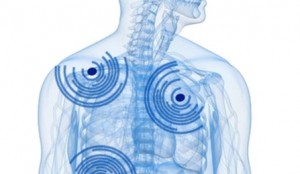 Chances are, someone you know has received an ultrasound exam – to get the first glimpse of their developing baby, or maybe to determine their risk of heart attack. An ultrasound works by sending out high-frequency sound waves which reflect off body structures. A computer will then receive these reflected waves and use them to create a picture that we see on a monitor.
Chances are, someone you know has received an ultrasound exam – to get the first glimpse of their developing baby, or maybe to determine their risk of heart attack. An ultrasound works by sending out high-frequency sound waves which reflect off body structures. A computer will then receive these reflected waves and use them to create a picture that we see on a monitor.
Whatever the use, ultrasound is one of the most utilized forms of diagnostic imaging available today after X-ray exams. But unlike an X-ray exam, an ultrasound has no ionizing radiation exposure. So what’s next for ultrasound?
Tommaso Melodia, PhD, an associate professor at the University at Buffalo, is working to develop a tiny network of ultrasonic sensors that are small enough to work together inside the body to help treat serious medical conditions such as diabetes and heart disease.
By allowing medical devices to essentially talk to each other via ultrasound, these sensors could revolutionize the way we provide patient care. Imagine, for example, a pacemaker that can communicate with an instrument that measures blood oxygen levels or an insulin pump that can respond to signals from a glucose monitor.
This is just scratching the surface. According to Melodia, there are countless other potential applications for this remarkable new technology.
“Think of how the Navy uses sonar to communicate between submarines and detect enemy ships,” Melodia said. “It’s the same principle, only applied to ultrasonic sensors that are small enough to work together inside the human body and more effectively help treat diseases.”
With the help of the NSF CAREER grant, the foundation’s most prestigious award in support of junior faculty who exemplify the role of teacher-scholars through outstanding research, Melodia will do more modeling and conduct experiments with ultrasonic, wireless body-sensor networks.
Read more about this research at the University at Buffalo News Center website.


Very interesting. Wireless technology can be a boon or a bane, depending on who you’re talking to. Microwave signals from wireless devices are highly controversial for their supposedly adverse effects, even though they are non-ionizing type of radiation. Ultrasound in this case seems to be a different matter, but wonder what the safety issues are, if any.
Wireless Technology is great. Thanks for sharing great info.